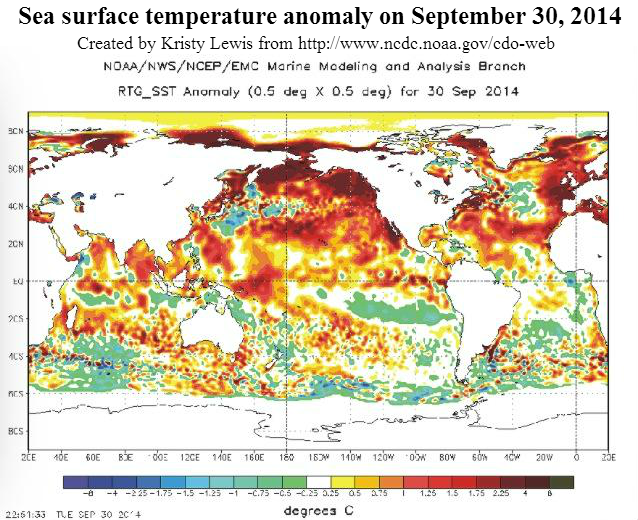The World Meteorological Organization’s annual Greenhouse Gas Bulletin shows that between 1990 and 2013 there was a 34% increase in radiative forcing – the warming effect on our climate – because of long-lived greenhouse gases such as carbon dioxide (CO2), methane and nitrous oxide.

In 2013, concentration of CO2 in the atmosphere was 142% of the pre-industrial era (1750), and of methane and nitrous oxide 253% and 121% respectively.
The ocean cushions the increase in CO2 that would otherwise occur in the atmosphere, but with far-reaching impacts. The current rate of ocean acidification appears unprecedented at least over the last 300 million years, according to an analysis in the report.
“We know without any doubt that our climate is changing and our weather is becoming more extreme due to human activities such as the burning of fossil fuels,” said WMO Secretary-General Michel Jarraud.
“The Greenhouse Gas Bulletin shows that, far from falling, the concentration of carbon dioxide in the atmosphere actually increased last year at the fastest rate for nearly 30 years. We must reverse this trend by cutting emissions of CO2 and other greenhouse gases across the board,” he said. “We are running out of time.”
The observations from WMO’s Global Atmosphere Watch network showed that CO2 levels increased more between 2012 and 2013 than during any other year since 1984.
NOAA data give a slightly lower CO2 growth figure for 2013, but even when extrapolating NOAA's data, some frightening trendlines appear, as illustrated by above image.

The WMO concludes that a reduction in RF (radiative forcing) from its current level (2.92 W·m
–2 in 2013) will require huge cuts in a number of emissions, not just in CO2.
In the figure on the right, the RF of the long-lived greenhouse gases (LLGHG) is plotted along with different emission reduction scenarios: (a) emissions held constant at 2013 levels, (b) constant CO2 emissions and 80% reduction in anthropogenic non-CO2 GHG emissions, (c) 80% reduction in CO2 emissions while non-CO2 GHG emissions are held constant, and (d) 80% reductions in all LLGHG emissions.
A recent study shows that the world not only continues to build new coal-fired power plants, but built more new coal plants in the past decade than in any previous decade. Worldwide, an average of 89 gigawatts per year (GW yr
–1) of new coal generating capacity was added between 2010 and 2012, 23 GW yr
–1 more than in the 2000–2009 time period and 56 GW yr
–1 more than in the 1990–1999 time period. Natural gas plants show a similar pattern.

Assuming these plants operate for 40 years, the fossil-fuel burning plants built in 2012 will emit approximately 19 billion tons of CO2 (Gt CO2) over their lifetimes, versus 14 Gt CO2 actually emitted by all operating fossil fuel power plants in 2012.
The study concludes that total committed emissions related to the power sector are growing at a rate of about 4% per year.
“Bringing down carbon emissions means retiring more fossil fuel-burning facilities than we build,” said Steven Davis, assistant professor of Earth system science at UCI and the study’s lead author. “But worldwide, we’ve built more coal-burning power plants in the past decade than in any previous decade, and closures of old plants aren’t keeping pace with this expansion.”
“Far from solving the climate change problem, we’re investing heavily in technologies that make the problem worse,” he added.

“We’ve been hiding what’s going on from ourselves: A high-carbon future is being locked in by the world’s capital investments,” said Socolow, professor emeritus of mechanical & aerospace engineering.
The IPCC in AR5 suggests there was a carbon budget to divide between nations (above image left), while largely ignoring potentially huge feedbacks such as albedo changes resulting from decline of snow and ice in the Arctic and methane eruptions from the seafloor of the Arctic Ocean.
These two feedbacks alone could each soon cause more warming than the warming directly caused by people's emissions since the start of the industrial revolution.
Sam Carana says: “There is no carbon budget to divide between nations, instead there is just a huge debt of CO2 to be removed from the atmosphere and the oceans. Comprehensive and effective action must be taken to stop run-away warming.”
Sam Carana continues: “No time before in human history has such a huge amount of ocean heat accumulated in the North Atlantic and the North Pacific.”
“This heat is now threatening to invade the Arctic Ocean and trigger huge temperature rises due to methane eruptions from the seafloor.”
“The heat is also melting Arctic sea ice from below, as the image below right shows, there now is hardly any sea ice left that is more than 3 meters (nearly 10 ft) thick.”

“Last year, this heat started to cause large methane eruptions from the Arctic Ocean's seafloor in early October, and this year temperatures in the Arctic Ocean are even higher.”
Meanwhile, mean global methane levels of 1839 ppb were recorded at several altitudes by the MetOp-1 satellite on the morning of September 7, 2014.
And ocean heat continues to invade the Arctic, as illustrated by the NOAA image below.
Links
- Record Greenhouse Gas Levels Impact Atmosphere and Oceans - WMO Press Release No. 1002
https://www.wmo.int/pages/mediacentre/press_releases/pr_1002_en.html
- WMO Greenhouse Gas Bulletin No. 10 | 9 September 2014
https://www.wmo.int/pages/mediacentre/press_releases/documents/1002_GHG_Bulletin.pdf
- NOAA Trends in Atmospheric Carbon Dioxide, Annual Mean Global CO2 Growth Rates
http://www.esrl.noaa.gov/gmd/ccgg/trends/global.html#global_growth
- Commitment accounting of CO2 emissions, by Steven J Davis and Robert H Socolow
http://iopscience.iop.org/1748-9326/9/8/084018
- Existing power plants will spew 300 billion more tons of carbon dioxide during use - News Release
http://news.uci.edu/press-releases/existing-power-plants-will-spew-300-billion-more-tons-of-carbon-dioxide-during-use




















































